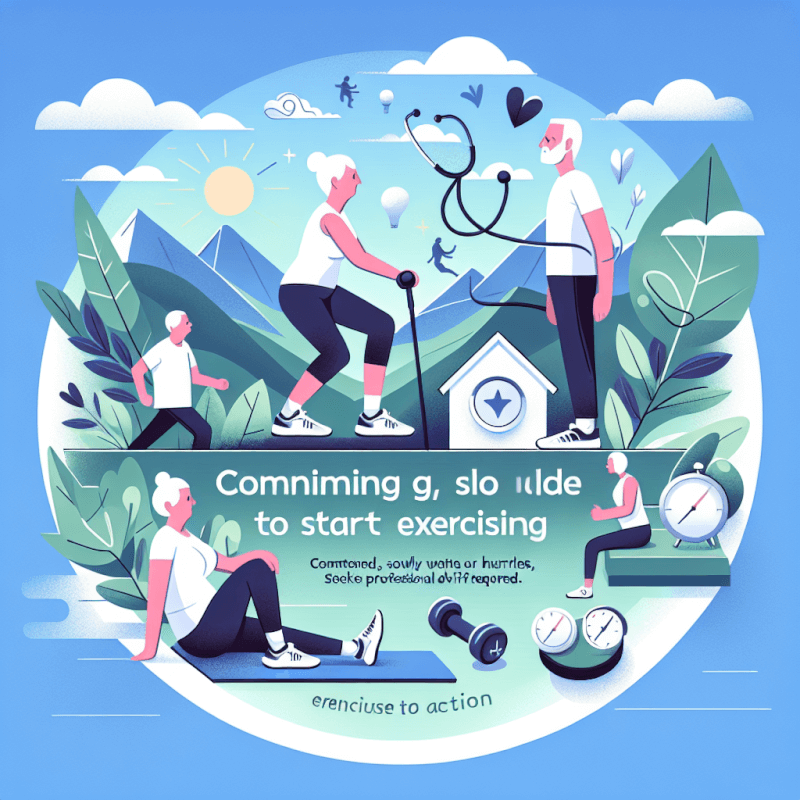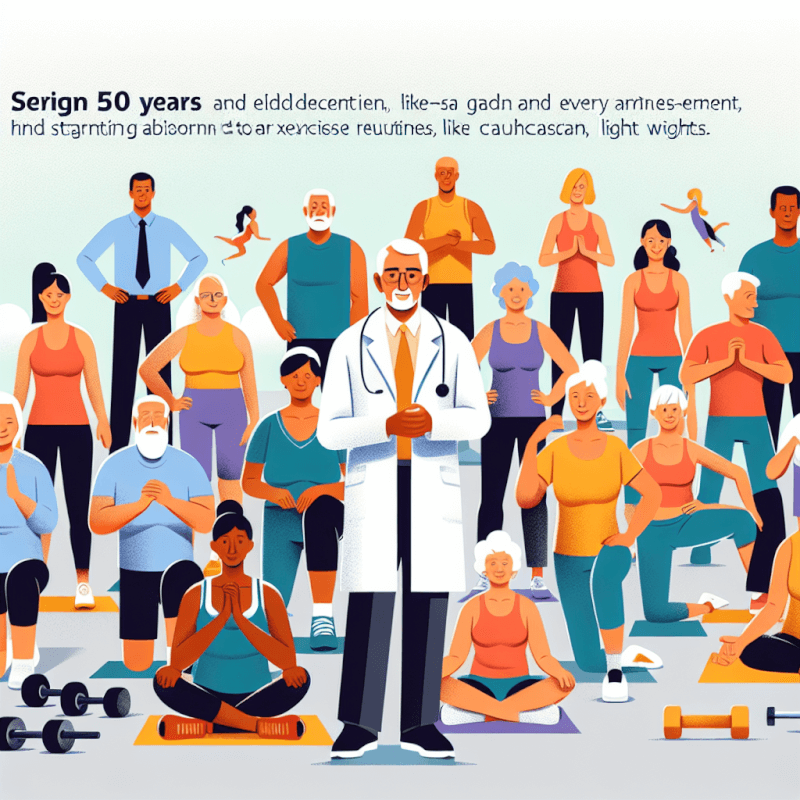Congratulations on reaching the golden age of 50! It’s a wonderful time to prioritize your health and well-being, and what better way to do so than by incorporating exercise into your daily routine? In this article, we will explore some valuable tips and strategies to help you embark on your fitness journey and start exercising at 50. Whether you’re a beginner or returning to fitness after a hiatus, these practical suggestions will guide you towards a healthier and happier lifestyle. So, let’s lace up those sneakers and get ready to embrace the incredible benefits of exercise at this stage of your life!

Setting Goals
Assessing your current fitness level
Before diving into a new exercise routine, it’s important to assess your current fitness level. Take a moment to reflect on your overall health, mobility, and endurance. Consider any physical limitations or pre-existing medical conditions that may impact your exercise choices. By understanding where you currently stand, you can create realistic goals that accommodate your unique circumstances.
Identifying your exercise preferences
Exercise doesn’t have to be a chore; it can be enjoyable and fulfilling. Take some time to explore different types of exercises and activities that align with your interests and lifestyle. Whether you prefer outdoor activities like hiking or cycling, or enjoy the camaraderie of group fitness classes, there are countless options available to suit your preferences.
Establishing realistic goals
Setting realistic goals is key to maintaining motivation and staying on track. Consider what you hope to achieve through exercise. Is it to improve your overall health, lose weight, or increase your energy levels? Once you have identified your goals, break them down into smaller, manageable milestones. Remember to be patient and give yourself time to progress gradually.
Consulting a Healthcare Professional
Getting a physical check-up
Before beginning any exercise program, it’s crucial to consult with a healthcare professional, especially if you’re starting at 50 or above. A physical check-up can help identify any underlying health concerns that may affect your ability to exercise safely. Your doctor can provide valuable guidance and recommendations tailored to your specific needs.
Discussing exercise plans and goals
During your doctor’s visit, openly discuss your exercise plans and goals. Share your intentions with your healthcare professional, including the types of exercises you are interested in pursuing. They can offer advice on the appropriate intensity, duration, and frequency of exercise that aligns with your current fitness level and health condition.
Addressing any medical concerns
Take the opportunity to address any specific medical concerns or conditions you may have. Your doctor can provide guidance and recommendations on exercises that accommodate your needs. They may even refer you to a specialized healthcare professional, such as a physical therapist, who can tailor exercises to address specific challenges or limitations.
Choosing the Right Exercises
Cardiovascular exercises
Cardiovascular exercises, also known as aerobic exercises, are essential for strengthening your heart and improving overall endurance. Examples of cardiovascular exercises include brisk walking, jogging, cycling, swimming, and dancing. These activities get your heart rate up and increase blood flow throughout your body, contributing to better cardiovascular health.
Strength training exercises
Strength training exercises are crucial for building muscle mass, increasing bone density, and improving overall strength. As we age, maintaining muscle strength becomes increasingly important for functional daily activities. Incorporate exercises with weights, resistance bands, or bodyweight exercises like push-ups, squats, and lunges. Start with lighter weights and gradually increase the resistance as you become more comfortable and stronger.
Flexibility and balance exercises
Flexibility and balance exercises are particularly important for older adults. These exercises improve joint mobility, enhance coordination, and reduce the risk of falls. Yoga, Pilates, tai chi, and basic stretching routines are excellent options to improve flexibility and balance. Focus on exercises that target different muscle groups and incorporate both static and dynamic stretches.
Starting Slowly and Gradually
Warming up and stretching
Before diving into your exercise routine, never skip the warm-up and stretching phase. Devote a few minutes to warm up your muscles by engaging in light cardio exercises such as marching in place or gentle arm circles. Follow it up with dynamic stretches that mimic the movements you’ll be doing during your workout to prepare your body for exercise.
Beginning with low-intensity exercises
Starting with low-intensity exercises is essential, especially if you are new to exercise or have been inactive for a while. Begin with activities such as brisk walking, swimming, or cycling at a gentle pace. Gradually increase the duration and intensity of your workouts as your fitness level improves. Remember, consistency is more important than intensity when you’re starting out.
Gradually increasing duration and intensity
As you become more comfortable and your fitness level improves, gradually increase the duration and intensity of your workouts. Challenge yourself by adding a few extra minutes to your routine or increasing the resistance or weight you are using. However, always listen to your body and avoid pushing yourself too hard too soon, as this may lead to injuries or burnout.

Finding Suitable Fitness Activities
Going for walks or hikes
Walking is an excellent low-impact exercise that can be easily incorporated into your daily routine. Not only does it improve cardiovascular health, but it also allows you to enjoy the outdoors and explore your surroundings. If you are up for a challenge, consider hiking in nature parks or trails to add variety and engage different muscle groups.
Cycling or swimming
Cycling and swimming are both gentle on the joints and offer immense health benefits. Cycling can be done outdoors or indoors on a stationary bike, making it a versatile option for individuals of all fitness levels. Swimming, on the other hand, is a full-body workout that provides resistance and improves cardiovascular fitness while being easy on the joints.
Joining fitness classes or clubs
Joining fitness classes or clubs can be a great way to stay motivated and connect with like-minded individuals. Look for local community centers or gyms that offer group exercise classes specifically designed for older adults. These classes may include activities such as aerobics, yoga, Zumba, or even water aerobics. Experiment with different classes to find one that suits your interests and fitness goals.
Building a Support Network
Enlisting a workout buddy
Exercising with a friend or family member can make physical activity more enjoyable and keep you motivated. Having a workout buddy not only adds a sense of accountability but also provides companionship during your exercise sessions. You can encourage and challenge each other, making it easier to stick to your fitness goals.
Joining online or local support groups
Online and local support groups provide valuable resources, guidance, and a sense of community for individuals starting their fitness journey. These groups may offer fitness challenges, share success stories, and provide a platform to discuss challenges and seek advice. By being part of a supportive network, you can find inspiration and motivation to continue on your path to a healthier lifestyle.
Seeking guidance from fitness professionals
If you are unsure about certain exercises, techniques, or have concerns about your form, consider seeking guidance from fitness professionals. Personal trainers or exercise specialists can provide personalized advice, create tailored workout plans, and ensure you are exercising safely and effectively. Their expertise can be especially beneficial, particularly if you have specific goals, limitations, or concerns.

Creating a Schedule and Sticking to It
Setting aside specific exercise time
To make exercise a consistent part of your routine, set aside specific time slots dedicated solely to physical activity. Treat it as an important appointment with yourself that cannot be missed. Whether it’s early morning, during lunch breaks, or in the evening, find a time that works best for you and commit to it.
Making it a routine
Creating a routine helps solidify exercise as a habit. Make it a point to incorporate physical activity into your daily life, just like brushing your teeth or having meals. Consistency is key when it comes to reaping the benefits of exercise, so aim for at least 150 minutes of moderate-intensity aerobic activity or 75 minutes of vigorous-intensity aerobic activity per week, along with strength training exercises on two or more days.
Rewarding yourself for consistency
Motivate yourself by setting small rewards for consistent exercise. Celebrate milestones such as completing a month of regular exercise or reaching a particular goal. Treat yourself to something you enjoy or engage in activities that relax and rejuvenate you. These rewards act as positive reinforcements, making exercise more enjoyable and reinforcing the habit.
Listening to Your Body
Recognizing signs of overexertion
While pushing your limits is important for progress, it’s equally vital to listen to your body and recognize signs of overexertion. Pay attention to excessive fatigue, shortness of breath, dizziness, or pain during or after exercising. If you experience any concerning symptoms, take a step back, and consult with your healthcare professional.
Allowing for rest and recovery
Rest and recovery are vital components of any exercise program, regardless of age. Your body needs time to repair and rebuild after physical activity. Allow for adequate rest days in between workouts to prevent burnout and reduce the risk of injury. Engaging in activities such as gentle stretching, meditation, or foam rolling can aid in muscle relaxation and recovery.
Modifying exercises as needed
As you progress with your fitness journey, you may need to modify exercises to accommodate your changing needs and abilities. If certain exercises become too challenging or uncomfortable, don’t be afraid to make adjustments. Work with your healthcare professional or a fitness specialist to find appropriate alternatives that still target the same muscles or provide similar benefits.

Maintaining a Healthy Lifestyle
Eating a balanced diet
Exercise and healthy eating go hand in hand. Fuel your body with a balanced diet that includes plenty of fruits, vegetables, whole grains, lean proteins, and healthy fats. Stay hydrated by drinking an adequate amount of water throughout the day. Consult with a registered dietitian if you need help creating a meal plan that complements your exercise routine and supports your health goals.
Getting enough sleep
Adequate sleep is crucial for overall health and well-being. During sleep, your body repairs tissues, consolidates memories, and supports immune function. Aim for 7-9 hours of quality sleep each night to allow your body to recover from physical activity and optimize its performance.
Managing stress levels
Exercise can play a crucial role in managing stress levels. However, it’s also important to incorporate other stress-relief practices into your daily routine. Consider meditation, deep breathing exercises, or engaging in activities that bring you joy and relaxation. Take time for self-care and prioritize activities that promote mental and emotional well-being.
Tracking Progress and Adjusting Goals
Keeping an exercise journal
Maintaining an exercise journal is a great way to track your progress and stay motivated. Record the exercises you perform, the duration, and any notes about how you felt during and after the workouts. This journal can help you identify patterns, reflect on your achievements, and hold yourself accountable to your fitness goals.
Regularly reassessing fitness goals
As you progress on your fitness journey, regularly reassess your goals to ensure they align with your current needs and aspirations. Gradually increase the intensity, duration, or frequency of your workouts once you’ve achieved your initial milestones. Setting new goals challenges you and prevents stagnation, keeping your exercise routine fresh and exciting.
Celebrating milestones and achievements
Don’t forget to celebrate your milestones and achievements along the way. Whether it’s losing a certain amount of weight, running your first 5K, or successfully completing a challenging exercise, acknowledge and reward yourself for your hard work and dedication. Take pride in your progress and use it as fuel to keep pushing forward. Remember, you are capable of achieving great things at any age!



